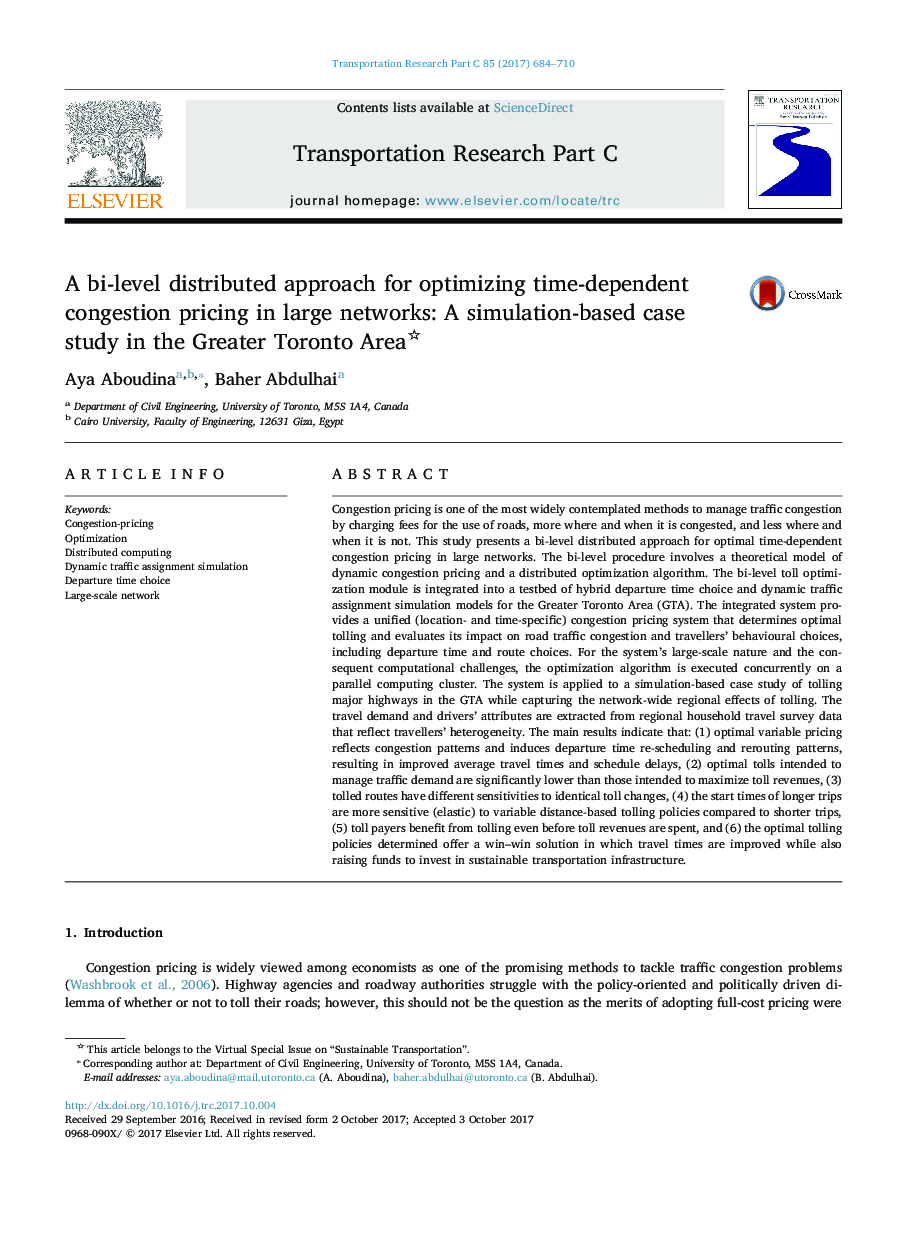| کد مقاله | کد نشریه | سال انتشار | مقاله انگلیسی | نسخه تمام متن |
|---|---|---|---|---|
| 6936319 | 1449663 | 2017 | 27 صفحه PDF | دانلود رایگان |
عنوان انگلیسی مقاله ISI
A bi-level distributed approach for optimizing time-dependent congestion pricing in large networks: A simulation-based case study in the Greater Toronto Area
ترجمه فارسی عنوان
یک روش توزیع دو سطحی برای بهینه سازی قیمت گذاری احتقان وابسته به زمان در شبکه های بزرگ: مطالعه موردی مبتنی بر شبیه سازی در منطقه تورنتو بزرگ
دانلود مقاله + سفارش ترجمه
دانلود مقاله ISI انگلیسی
رایگان برای ایرانیان
کلمات کلیدی
هزینه حمل و نقل، بهینه سازی، محاسبات توزیع شده، شبیه سازی تخصیص ترافیک پویا، انتخاب زمان خروج، شبکه گسترده
موضوعات مرتبط
مهندسی و علوم پایه
مهندسی کامپیوتر
نرم افزارهای علوم کامپیوتر
چکیده انگلیسی
Congestion pricing is one of the most widely contemplated methods to manage traffic congestion by charging fees for the use of roads, more where and when it is congested, and less where and when it is not. This study presents a bi-level distributed approach for optimal time-dependent congestion pricing in large networks. The bi-level procedure involves a theoretical model of dynamic congestion pricing and a distributed optimization algorithm. The bi-level toll optimization module is integrated into a testbed of hybrid departure time choice and dynamic traffic assignment simulation models for the Greater Toronto Area (GTA). The integrated system provides a unified (location- and time-specific) congestion pricing system that determines optimal tolling and evaluates its impact on road traffic congestion and travellers' behavioural choices, including departure time and route choices. For the system's large-scale nature and the consequent computational challenges, the optimization algorithm is executed concurrently on a parallel computing cluster. The system is applied to a simulation-based case study of tolling major highways in the GTA while capturing the network-wide regional effects of tolling. The travel demand and drivers' attributes are extracted from regional household travel survey data that reflect travellers' heterogeneity. The main results indicate that: (1) optimal variable pricing reflects congestion patterns and induces departure time re-scheduling and rerouting patterns, resulting in improved average travel times and schedule delays, (2) optimal tolls intended to manage traffic demand are significantly lower than those intended to maximize toll revenues, (3) tolled routes have different sensitivities to identical toll changes, (4) the start times of longer trips are more sensitive (elastic) to variable distance-based tolling policies compared to shorter trips, (5) toll payers benefit from tolling even before toll revenues are spent, and (6) the optimal tolling policies determined offer a win-win solution in which travel times are improved while also raising funds to invest in sustainable transportation infrastructure.
ناشر
Database: Elsevier - ScienceDirect (ساینس دایرکت)
Journal: Transportation Research Part C: Emerging Technologies - Volume 85, December 2017, Pages 684-710
Journal: Transportation Research Part C: Emerging Technologies - Volume 85, December 2017, Pages 684-710
نویسندگان
Aya Aboudina, Baher Abdulhai,
